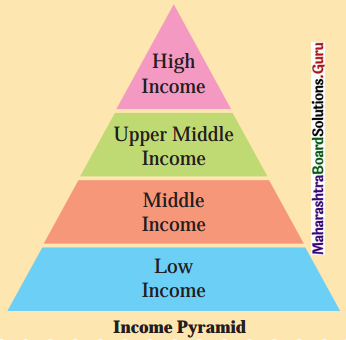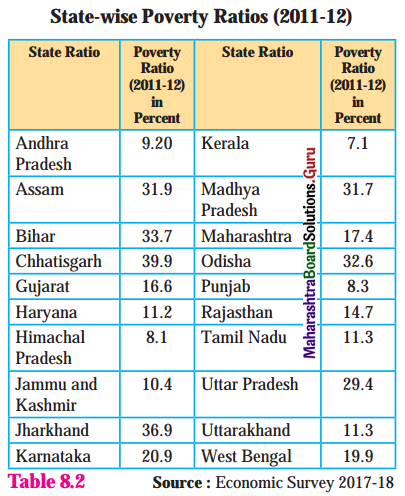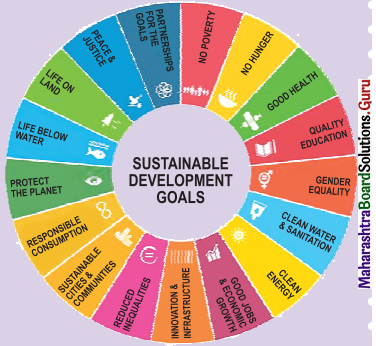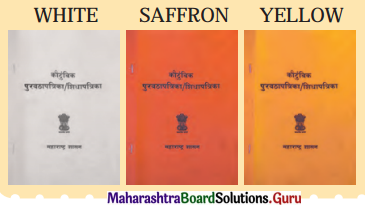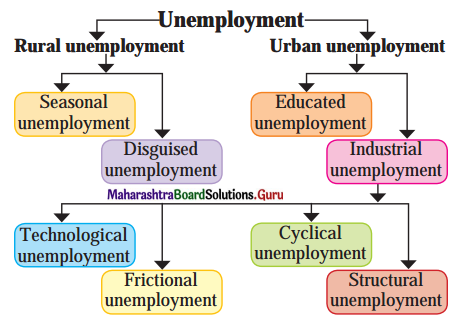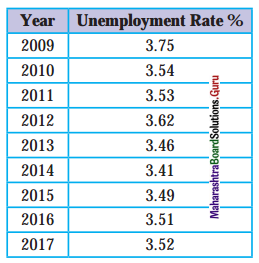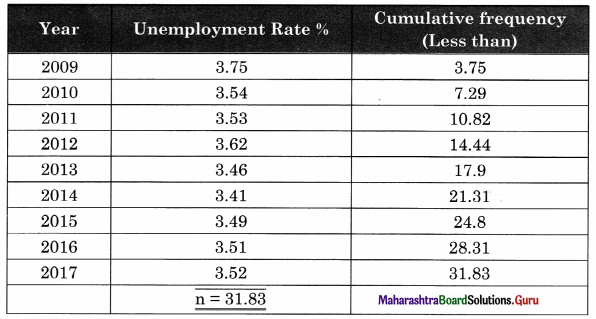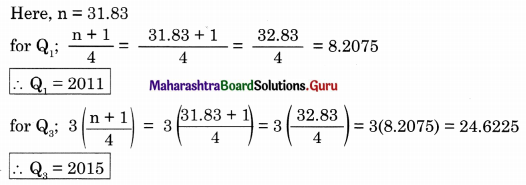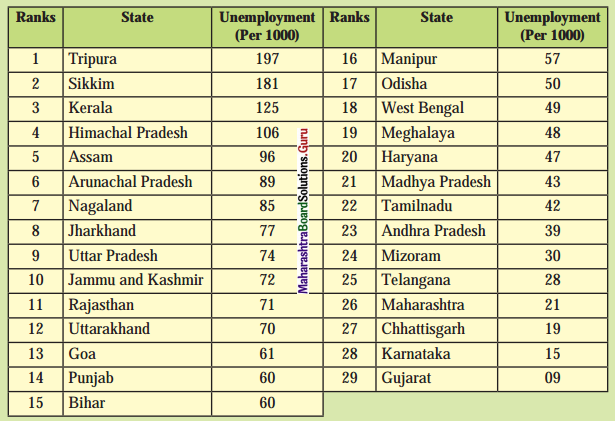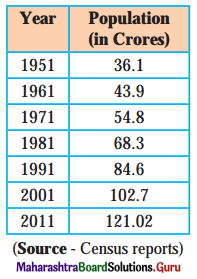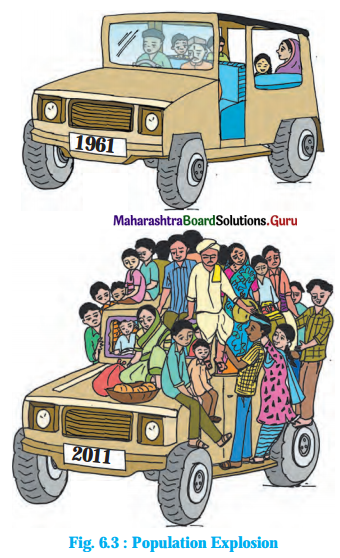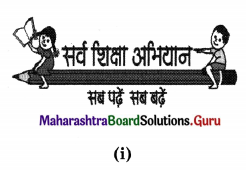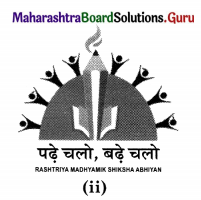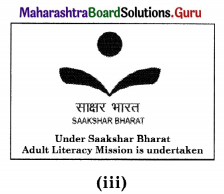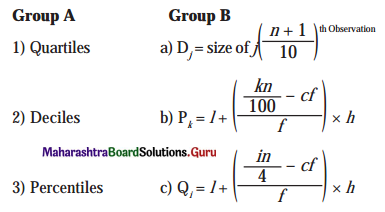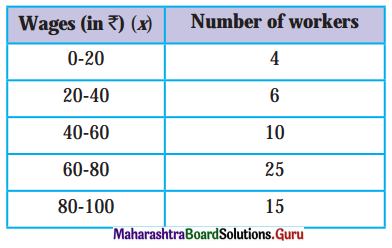Balbharti Maharashtra State Board Class 11 Economics Solutions Chapter 9 Economic Policy of India Since 1991 Textbook Exercise Questions and Answers.
Std 11 Economics Chapter 9 Question Answer Economic Policy of India Since 1991 Maharashtra Board
Class 11 Economics Chapter 9 Economic Policy of India Since 1991 Question Answer Maharashtra Board
Economics Class 11 Chapter 9 Question Answer Maharashtra Board
1. Complete the following statements by choosing the correct alternative:
Question 1.
After Independence, India had adopted ____________
(a) Socialism
(b) Capitalism
(c) Mixed Economy
(d) Communism
Answer:
(c) Mixed economy
Question 2.
The new economic policy approved foreign technology in ____________
(a) Cottage industries
(b) Small scale industries
(c) Micro enterprises
(d) High priority industries
Answer:
(d) High priority industries
![]()
Question 3.
At present, the number of industries reserved for public sector has been reduced to ____________
(a) 3
(b) 5
(c) 7
(d) 2
Answer:
(d) 2
2. Assertion and Reasoning questions:
Question 1.
Assertion (A): Delicensing of industries was an important step taken under liberalization.
Reasoning (R): Unwanted controls and restrictions led to economic stagnation prior to 1991.
(a) (A) is TRUE but (R) is FALSE
(b) (A) is FALSE but (R) is TRUE
(c) (A) and (R) both are TRUE and (R) is the correct explanation of (A)
(d) (A) and (R) both are TRUE but (R) is not the correct explanation of (A)
Answer:
(c) (A) and (R) both are TRUE and (R) is the correct explanation of (A)
Question 2.
Assertion (A): In 1990-91, India faced an acute shortage of foreign exchange reserves.
Reasoning (R): Import quotas and tariffs led to an increase in imports.
(a) (A) is TRUE but (R) is FALSE
(b) (A) is FALSE but (R) is TRUE
(c) (A) and (R) both are TRUE and (R) is the correct explanation of (A)
(d) (A) and (R) both are TRUE but (R) is not the correct explanation of (A)
Answer:
(a) (A) is TRUE but (R) is FALSE
Question 3.
Assertion (A): Post liberalization, the sale of domestic goods has increased.
Reasoning (R): The demand for imported goods had increased due to liberal policy.
(a) (A) is TRUE but (R) is FALSE
(b) (A) is FALSE but (R) is TRUE
(c) (A) and (R) both are TRUE and (R) is the correct explanation of (A)
(d) (A) and (R) both are TRUE but (R) is not the correct explanation of (A)
Answer:
(b) (A) is FALSE but (R) is TRUE
![]()
Question 4.
Assertion (A): Due to Globalisation, a country cannot achieve self-sufficiency in food production.
Reasoning (R): Globalisation has created a revolution in the IT sector.
(a) (A) is TRUE but (R) is FALSE
(b) (A) is FALSE but (R) is TRUE
(c) (A) and (R) both are TRUE and (R) is the correct explanation of (A)
(d) (A) and (R) both are TRUE but (R) is not the correct explanation of (A)
Answer:
(d) (A) and (R) both are TRUE but (R) is not the correct explanation of (A)
3. Find the odd word out:
Question 1.
New Economic Policy – Liberalization, Privatization, Demonetization, Globalisation
Answer:
Demonetization
Question 2.
Industries requiring compulsory licensing – defense equipment, agro-based industries, cigarettes, industrial explosives
Answer:
agro-based industries
Question 3.
Navratna status companies – SPCL, IOC, ONGC, HPCL
Answer:
SPCL
Question 4.
Liberalization dealt with the following – MRTP, FERA, SEBI, NTPC
Answer:
NTPC
4. Identify and explain the concepts from the given illustrations:
Question 1.
Vehicles manufactured by various automobile companies are now available in India.
Answer:
Globalization.
Globalization means the interaction of the domestic economy with the rest of the world with regard to foreign investment, trade, production, and financial matters.
![]()
Question 2.
Government equity in some public sector enterprises is sold to the private sector.
Answer:
Disinvestment.
A disinvestment is an act of selling shares of sick public sector units to the private sector.
Eg. Disinvestment of Maruti, ITDC hotels, VSNL, etc.
Question 3.
Foreign investments are encouraged on a large scale in the industrial sector of India.
Answer:
Foreign Direct Investment (FDI).
FDI was approved under the Industrial Policy of 1991, to encourage investment in high-priority industries which require high investment and technology.
5. State with reasons whether you agree or disagree with the following statements:
Question 1.
Liberalization has permitted the use of foreign technology.
Answer:
- Yes, I do agree with the statement.
- Liberalization has encouraged foreign technology.
- Foreign technology is allowed in high-priority industries.
- Foreign technology helps to reduce the cost and make the industries competitive.
Question 2.
The government has given private enterprises free access to the public sector.
Answer:
Yes, I do agree with the statement.
- 17 industries were reserved for the public sector under the Industrial Policy of 1956.
- But in NEP – 1991, the number of public sector industries reduced from 17 to 2.
- Railway transport and atomic energy are reserved for the public sector.
- The involvement of the private sector in economic activities has increased after NEP.
![]()
Question 3.
Government has a monopoly in the insurance sector.
Answer:
No, I do not agree with the statement.
- The insurance sector was a monopoly of the Government till 1991.
- In 1991IRDA (Insurance Regulatory and Development Authority Act) was introduced.
- The IRDA has given licenses to many private companies to start insurance businesses in India.
- Due to the entry of private companies, the monopoly of government has come to an end.
Question 4.
The creation of the National Renewal Board (NRB) was done to remove poverty.
Answer:
Yes, I do agree with the statement.
- Under the public sector, some units were closed due to loss.
- The workers of these units had to face the problem of unemployment and poverty.
- To solve this problem, the government has been formed. National Renewal Board (NRB).
- NRB provides compensation to retrenched workers which help to reduce poverty in the country.
Question 5.
Indian Oil Corporation is one of the public sector units among ‘Navratnas’.
Answer:
Yes, I do agree with the statement.
- Navratnas are the Public Sector Units (PSUs).
- In 1997-98, Nine PSUs were selected for Navratna status.
- These PSUs were selected on the basis of their performance.
- These Navratnas were given full financial and managerial autonomy.
6. Answer in detail:
Question 1.
Explain the features of the New Economic Policy of 1991.
Answer:
The process of the new economic policy started in 1985 and got momentum in 1991.
Features of Economic Policy, 1991:
- Delicensing: The new industrial policy abolished all industrial licensing, except 18 specified industries related to security and strategic concerns and social reasons.
- Abolition of MRTP Act: No prior approval of the MRTP commission is now required for setting up industrial units by the large business houses.
- Encouragement to Small Scale Industries (SSI): The investment limit of the SSI has been increased up to 5 crores which will help to upgrade their machinery.
- Encouraging Foreign Investment: Many industrial units were open to foreign investment under the 1991 policy. The limit was raised to 51% and 100% in some industries and 100% in mining, pollution control equipment, electricity generation projects, ports, etc.
- Reducing the role of the Public Sector: The number of industries reserved for the public sector was reduced from 17 to 2, it includes railways and atomic energy.
- Trade Liberalisation: Relaxation is given to importers by abolishing import licensing controls. The permission for external credit and set up of Special Economic Zones (SEZ) to promote export. To promote agricultural export Agro Export Zones (AEZ) were introduced.
- Reforms in Insurance Sectors: The Insurance Regulatory and Development Authority Act (IRDA) has given licenses to many private companies to start insurance businesses which ended the monopoly of government e.g. Max Life, Bajaj, Allianz, Aegon, etc.
- Reforms in Financial Sector: The NEP has allowed private banks and foreign banks to do hanking business in the financial sector.
![]()
Question 2.
Explain the measures undertaken for Globalisation.
Answer:
Globalization means the interaction of the domestic economy with the rest of the world with regard to foreign investment, trade, production, and financial matters.
Measures were taken for Globalisation:
- Removal of quantitative restrictions: To make the Indian economy attractive to foreign investors, the government has reduced custom duties and tariffs imposed on imports and exports.
- Encouragement to foreign capital: To India, foreign investment has wider scope since 1991. Foreign capital is allowed in India without any restrictions.
- Convertibility of Rupee: It means Indian currency can be converted into the currency of other countries.
- Foreign collaboration: To take the benefit of advanced technology, Indian companies are allowed to enter into foreign collaboration e.g. Maruti-Suzuki, Hero-Honda, etc.
- Long-term trade policy: The trade policy was introduced for a longer duration to promote foreign trade.
- Encouragement to export: Many incentives have been given to industries through EXIM policy. SEZ and AEZ are created to encourage export.
7. Read the following passage carefully and answer the questions:
The Indian ice cream industry is one of the fastest-growing segments of the dairy and food processing sector. India has a low per capita consumption of ice cream of 400 ml whereas in the USA it is 22,000 ml and in China, it is 3000ml.
The per capita consumption of ice cream is low in India because it is a country filled with traditional sweets of more than 100 varieties. In developed countries, people have either pastries or ice-creams for dessert. In the era of globalization, the mindset of the people is fast changing. This is because multi-national companies have set up a number of ice-cream parlors, with a lot more varieties and flavours that attract the younger lot. Besides this, there are better delivery systems.
The ice-cream sector has great potential for growth in the country due to improvement in the cold chain infrastructure, increasing disposable income, and changing the lifestyle of the people. However, it is taxed higher with 18 percent GST while other dairy products in the same basket such as butter and cheese are taxed at 12 percent.
The ice-cream industry has generated revenue of more than $1.5 billion in 2016-17. With the employment of 15 lakh people directly or indirectly, it is also considered one of the largest employers of the dairy and food processing industry.
Question 1.
Identify the reason for the low per capita consumption of ice cream in India.
Answer:
In India, traditional sweets are available, which are having more than 100 varieties.
![]()
Question 2.
Explain the impact of globalisation on the Indian ice-cream industry.
Answer:
Due to globalisation, multinational companies have set up a number of ice-cream parlours with a lot of varieties and flavours. It helps to attract the younger generation of today.
Question 3.
Find out the factors that could lead to the growth of the ice-cream industry in India.
Answer:
In India Ice-cream industry has wider scope because there is an improvement in cold chain infrastructure, increase in disposable income, and changing lifestyle of the people.
Question 4.
Express your views about the implications of higher GST on the ice-cream industry in India.
Answer:
The ice-cream sector is indirectly dependent on the primary sector. If the demand for ice cream increased then the income of cattle owners will grow. 18% GST on ice cream is high because ice cream is made from milk which is good for health as compared to tobacco, pan masala. Same GST (18%) is imposed on tobacco and pan masala but it is injurious to health and finally, the burden of GST will transfer to customers.
11th Economics Digest Chapter 9 Economic Policy of India Since 1991 Intext Questions and Answers
Find out: (Textbook Page No. 58)
Names of five Private Banks and Foreign Banks.
Answer:
- Private Banks – ICICI Bank, Axis Bank, Kotak Mahindra Bank, Yes Bank, HDFC Bank.
- Foreign Banks – Standard Chartered Bank, DBS Bank, Doha Bank, Bank of America, Royal Bank of Scotland.
Find out: (Textbook Page No. 60)
Names of companies coming under Maharatna and Miniratna status.
Answer:
Maharatna
- Coal India Ltd.
- Gas Authority of India (GAIL)
- Indian Oil Corporation Ltd (IOCL)
- Mahanagar Telephone Nigam Ltd. (MTNL)
![]()
Miniratna
- Airports Authority of India
- Bharat Earth Movers Ltd.
- Bharat Dynamics Ltd.
- Mazagon Dock Ltd.
- State Trading Corporation of India
Stimulate your memory: (Textbook Page No. 61)
What is Corporate Social Responsibility (CSR)? How does it help society?
Answer:
- CSR means whatever a company does to give back to the community in which it has a presence.
- It is the company’s effort to improve society and the environment in some way.
- It helps society by providing education, healthcare, disaster relief measures, economic empowerment, planting trees, maintaining parks, etc.
- E.g. Mahindra & Mahindra constructed 4340 toilets in 104 districts of India, especially for girls in Government schools in 2013-14.
Activity-Based Questions
Observe the chart and answer the following question.

Question 1.
What is globalisation?
Answer:
Globalisation is a process of integrating the domestic economy with the rest of the world with regard to foreign investment, trade, production, and financial matters.
![]()
Question 2.
Explain the concept of disinvestment.
Answer:
Disinvestment is a process of selling shares of sick Public Sector Units (PSUs) to the private sector, so as to increase the production activities of that units and to achieve efficiency in the allocation of resources, improvement in management, etc.
E.g. Disinvestment of Maruti, ITDC hotels. IPCL. VSNL, etc.
Question 3.
Write the full form of FERA, SEZ, AEZ.
Answer:
- FERA – Foreign Exchange Regulation Act
- SEZ – Special Economic Zones
- AEZ – Agro Export Zones
Question 4.
Why NRB is created?
Answer:
National Renewal Board was created to look after the retrenched workers who become unemployed due to the closure of loss-making Public Sector Units (PSUs). Through this Board, the government took the responsibility of providing compensations to the retrenched workers and also to take care of those seeking voluntary retirement
![]()
Question 5.
By what was FERA replaced and why?
Answer:
FERA was replaced by FEMA to encourage international trade and to bring flexibility in the laws relating to foreign exchange.
11th Std Economics Questions And Answers:
- Basic Concepts in Economics Class 11 Economics Questions And Answers
- Money Class 11 Economics Questions And Answers
- Partition Values Class 11 Economics Questions And Answers
- The Economy of Maharashtra Class 11 Economics Questions And Answers
- Rural Development in India Class 11 Economics Questions And Answers
- Population in India Class 11 Economics Questions And Answers
- Unemployment in India Class 11 Economics Questions And Answers
- Poverty in India Class 11 Economics Questions And Answers
- Economic Policy of India Since 1991 Class 11 Economics Questions And Answers
- Economic Planning in India Class 11 Economics Questions And Answers
